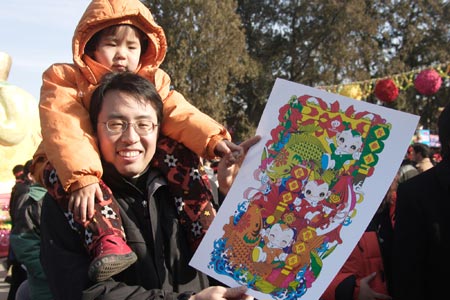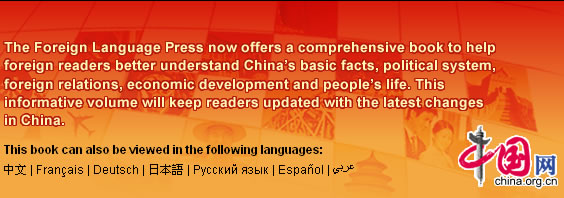The Chinese spoken and written language by the Han people is also the most commonly used language in China, as well as one of the most commonly used languages in the world. Chinese, also known as Hanyu or Han Chinese, comprises seven major dialect groups that are composed of over 100 sub-dialects. These dialects are major components of the splendid Chinese culture, playing a unique role in the formation and development of the Chinese nation.
 |
A father buys his daughter a piece of new year picture before the traditional Spring Festival.
Except for the Hui and Manchu peoples who use Han Chinese, the remaining 53 ethnic minorities have their own languages. Generally speaking, one ethnic group uses one language, but there are those that use two or more languages. Because of this, there are a total of 72 ethnic minority languages being used in China today.
 |
The Chinese language gains increasing popularity in the world. Pictured are some overseas students studying in China asking their Chinese classmates questions concerning the language learning.
These languages, except for Korean and Gin, whose relationships have not been classified, belong respectively to the Sino-Tibetan family, the Altaic family, the Austro-Asiatic family, the Austronesian family and the Indo-European family of languages.
Archaeological findings and research results indicate a total of 57 ethnic minority scripts have been used within the boundaries of China since ancient time, and 22 ethnic minorities in China are using 28 written languages of their own. In China, the spoken and written languages of ethnic minorities are widely used in the fields of law and justice, administration, education, political and social life, and other areas. When important meetings, such as national congresses of the Communist Party of China and sessions of the National People's Congress and the National Committee of the Chinese People's Political Consultative Conference, are held, the documents of the meetings are available in Mongolian, Tibetan, Uygur, Kazak, Korean, Yi and Zhuang, and simultaneous interpretations in those languages are also provided.
 |
Artists from Xinjiang Uygur Autonomous Region are performing folk songs and dances. Each minority ethnic group in China has its own unique culture and versatile dances in its repertoire.
The minority groups of Mongolian, Tibetan, Uygur, Kazak, Kirgiz, Korean, Yi, Dai, Lahu, Jingpo, Xibe and Russian have their own scripts, most of which have a long history. Of these, Mongolians in the Mongolian-inhabited areas use alphabetic scripts, written vertically, while those living in Xinjiang Uygur Autonomous Region use different alphabetic scripts that fit local dialect features. The Dais in Yunnan Province use four kinds of scripts in different areas.
Most of the Lisu Christians use a Lisu script based on the Roman alphabet, which uses only upper case letters as well as inverted upper case letters. There are also a small number who use syllabic Lisu writing, created by locals. The Va Christians in Yunnan use a Va script based on the letters of Roman alphabet. Some Zhuang, Bai and Yao peoples use ethnic scripts that are prominently influenced by Han Chinese scripts.
The Mongolian, Tibetan, Uygur, Korean and Yi languages have coded character sets and national standards for fonts and keyboard. Software in the Mongolian, Tibetan, Uygur and Korean languages can be run in the Windows operating system, and laser photo-typesetting in these languages has been realized. Applied software in languages of ethnic minorities are emerging one after another, and some achievements have been made in research into the OCR (optic character recognition) of languages of ethnic minorities and machine-aided translation.








